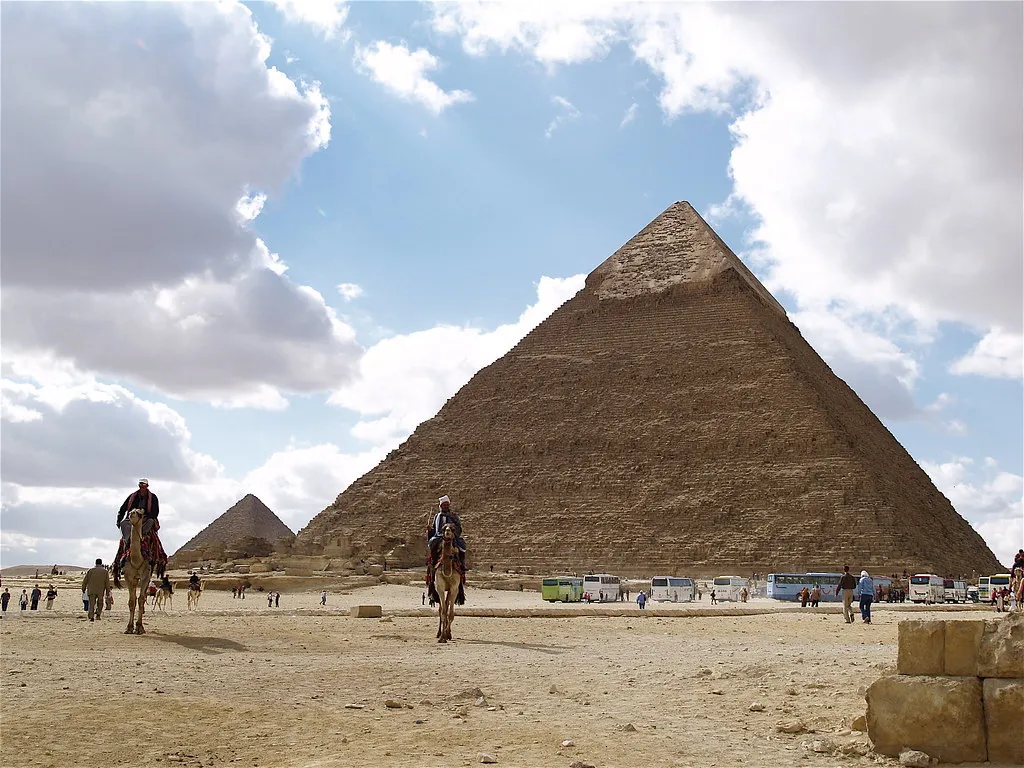Missing Great Pyramid Artifact Found in Cigar Box in Scotland
The wood fragments—among just three items ever taken from the Giza tomb—date to the fourth millennium B.C.
:focal(526x385:527x386)/https://tf-cmsv2-smithsonianmag-media.s3.amazonaws.com/filer/c8/b4/c8b473ea-46ce-4771-8a65-7644ece0bcd2/wood_fragments.jpg)
In 1872, two British men took a trio of artifacts from the Great Pyramid of Giza—the only known items ever removed from the 4,500-year-old structure. One of these objects, a five-inch piece of cedar wood, found its way to the University of Aberdeen in Scotland, only to disappear shortly after its arrival. Now, a curatorial assistant has rediscovered the artifact, which apparently spent decades misfiled in the university museums’ Asia collections.
As Jessie Yeung reports for CNN, Abeer Eladany, an archaeologist originally from Egypt who previously worked at the Egyptian Museum in Cairo, was reviewing items in the archives when she spotted a cigar box decorated with Egypt’s former flag.
“Once I looked into the numbers in our Egypt records, I instantly knew what it was, and that it had effectively been hidden in plain sight in the wrong collection,” says Eladany in a statement. “I’m an archaeologist and have worked on digs in Egypt but I never imagined it would be here in northeast Scotland that I’d find something so important to the heritage of my own country.”
Exactly what the wood’s original purpose was remains unclear, but some researchers have suggested it might be part of a measuring tool and could hold clues to the monument’s construction.
Structural engineer Waynman Dixon and his friend James Grant, a physician and adventurer, removed the wood during an 1872 investigation undertaken with the permission of the Egyptian Antiquities Service, which was established in the mid-19th century to stop the illicit trade of the country’s ancient artifacts. The pair took three items from the pyramid’s Queen’s Chamber; known as the “Dixon relics,” two—a ball and a hook—are now housed at the British Museum.
Grant kept the wood until his death in 1895, and in 1946, his daughter donated it to the university. But the unassuming fragments were never classified for archival purposes and, despite an extensive search, they remained hidden for decades.
Carbon dating of the rediscovered wood pieces has also raised new questions, reports Jessica Murray for the Guardian. As it turns out, the fragments date to between 3341 and 3094 B.C.—about 500 years before historical records suggest the pyramid was built, during the reign of the Pharaoh Khufu (2580 to 2560 B.C.).
“Finding the missing Dixon Relic was a surprise but the carbon dating has also been quite a revelation,” says Neil Curtis, head of museums and special collections at the university, in the statement. “It is even older than we had imagined.”
Curtis speculates that the date could simply reflect the age of the wood, which may have come from a long-lived tree. It’s also possible that the wood was harvested centuries before the pyramid was built, then conserved or recycled due to the scarcity of trees in ancient Egypt. Another potential explanation is that the pyramid’s builders deliberately chose to use an antique item to link Khufu with the past. Later Egyptians took similar steps during the time of the New Kingdom (1570 to 1070 B.C.).
“This discovery will certainly reignite interest in the Dixon Relics and how they can shed light on the Great Pyramid,” says Curtis.
According to CNN, 18th- and 19th-century archaeologists tried to use explosives to access the Giza pyramid’s narrow tunnels and chambers. Today, however, researchers use robots and remote cameras to investigate the ancient structure’s interior. The university notes that a 1993 robotic exploration of the pyramid gave archaeologists a view of the much larger piece of wood that the cedar belonged to.
Constructed to house Khufu’s remains, the pyramid features just three known interior spaces: the Queen’s Chamber, the King’s Chamber and the Grand Gallery. (A 2017 study used cosmic rays to reveal evidence of an additional cavity known colloquially as the “Big Void,” but details on the chamber, including its size, purpose and contents, are scarce.)
As Alicja Zelazko explains for Encyclopedia Britannica, the majority of the towering tomb is actually just solid limestone. Most of its subterranean chambers remain unfinished, and those that were completed “would have been very austere, as Egyptians only began decorating burial chambers with hieroglyphic texts” later. By the time Dixon and Grant arrived on the scene, virtually all of the artifacts once housed in the pyramid had long since been looted.
/https://tf-cmsv2-smithsonianmag-media.s3.amazonaws.com/accounts/headshot/Livia_lg_thumbnail.png)

/https://tf-cmsv2-smithsonianmag-media.s3.amazonaws.com/filer/69/c1/69c14b85-2855-40e9-a6c7-09a2e8522e42/box_in_which_wood_was_found.jpeg)
/https://tf-cmsv2-smithsonianmag-media.s3.amazonaws.com/accounts/headshot/Livia_lg_thumbnail.png)